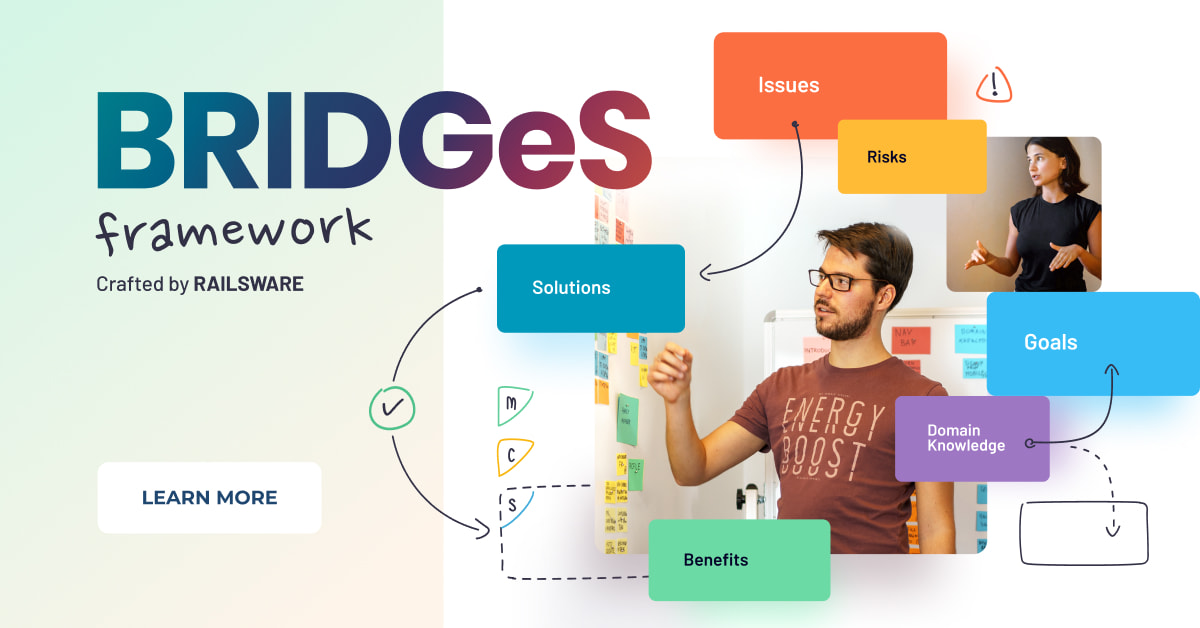Earlier, we blogged about the lean canvas* – a startup-friendly idea validation tool. Now, we want to pay tribute to the solution that underlies it – the business model canvas**. So, let’s talk about a sort of a business plan that you can scale in a one-page table.
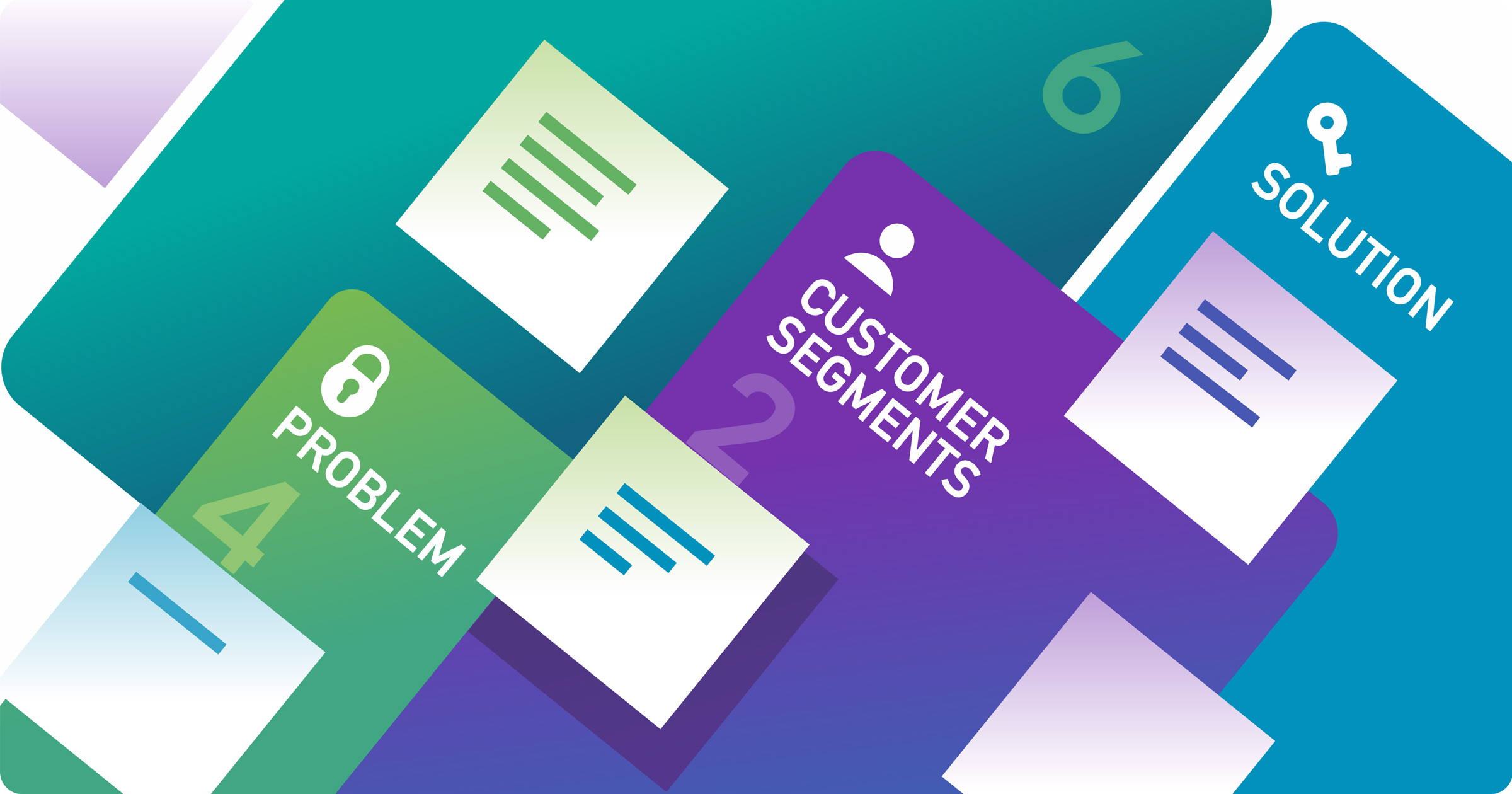
Here is a short intro to the business model canvas framework. It is the brainchild of Alexander Osterwalder. He offered it as an alternative to the business plan, which he considered a time-waster. The idea was to single out the crucial components of a company that are required to make money. Thus, you get nine sections on the canvas to fill in with relevant data.
Hard to believe, but this document can replace pages of analytics and formulas. And that’s just one of the advantages if we compare business model canvas vs. business plan. What else does this tool have to offer?
Why entrepreneurs love business model canvas
Time-efficient and flexible
Time is one of the most precious assets in the business world. And Osterwalder’s tool helps you use it efficiently. All the elements of business model canvas are easy-to-understand of what to be filled in. We do not promise you will have a handle on it within 20 minutes or less. But within a few hours, you’ll get an aggregated break up of what you need to generate revenue. Moreover, once it is done, you can and most likely will update the canvas over time. Business plans won’t grant you such flexibility.
Risk-identifying
The canvas provides you with input data to identify risks at an early stage. You can measure most of the bottlenecks to build a high-performance growth strategy. This is not a guarantee to avoid failure. But you’ll know your weak points and be able to pivot if needed.
Value-centered
Of all the business model canvas elements, Value Propositions are pivotal. It tells you why your business exists and what value it delivers. We can say that the entire business model canvas is built around this section. As a result, you get a wide scope of jobs to be done and versatile supporting inputs. You won’t find any irrelevant data on the canvas. The graphical design beacons essential information required to grow your business.
Self-intuitive
The tool is very intuitive. Some users don’t even need the business model canvas explained to start working with it. Indeed, you don’t have to be a genius to get the hang of it. Moreover, the canvas is built using a common language. This makes it easy-to-understand by both internal and external stakeholders.
By the way, we are hiring. Check out our job openings.
How to get started with the business model canvas?
Now, it’s time to shift from product-centric thinking towards business model ideation. We’ll explain how to fill in the components of business model canvas step by step. So, try out the flow yourself using this editable template by Mural. Also, you can download the canvas from Strategyzer.
In our video, we used Uber to explain the lean canvas. Let’s pick this company here as well to display real-life examples.
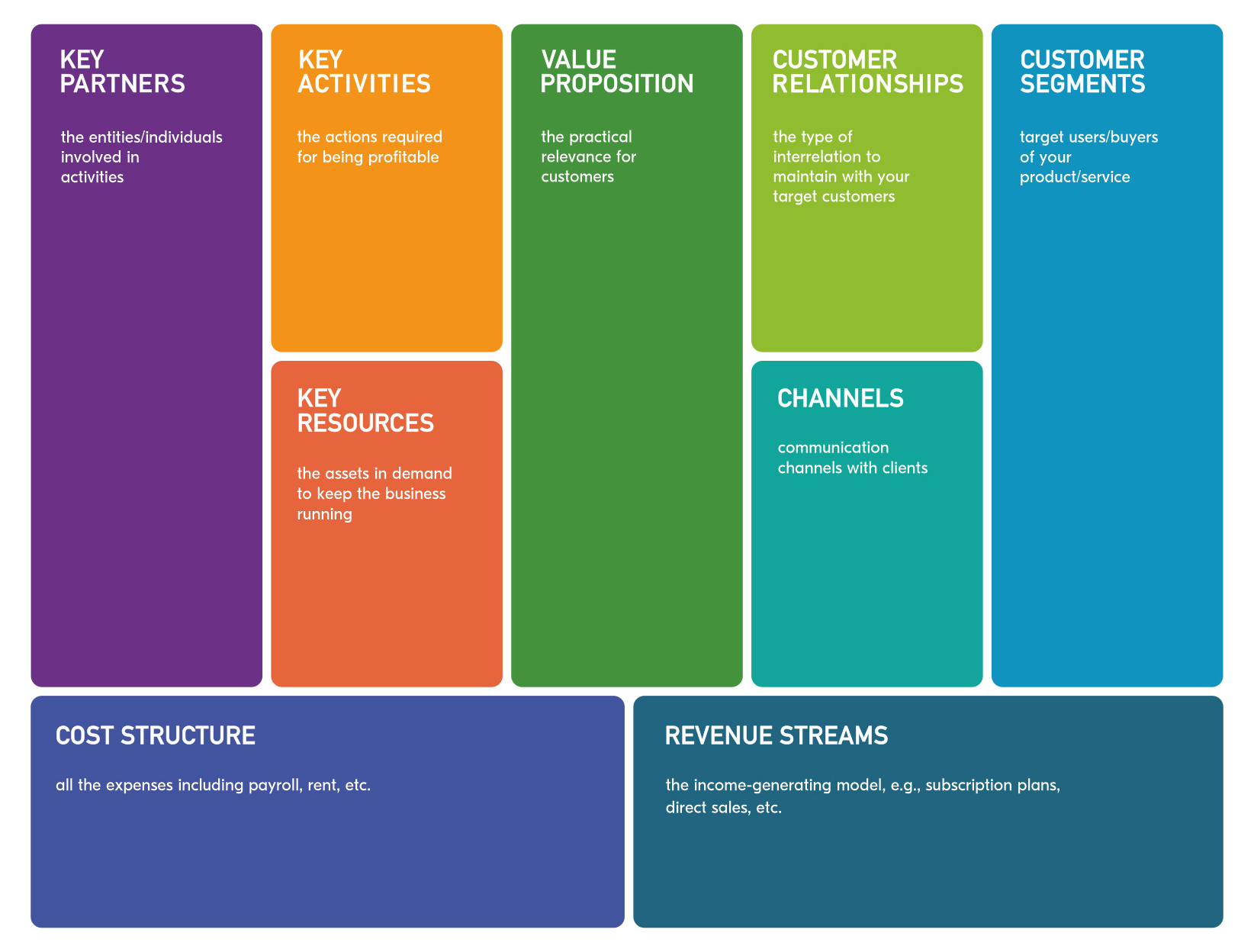
Customer Segments
Alexander recommends you to start with this section. Try to figure out who is the most important customer you’re delivering value to. The Persona method can help you create an imaginary representation of user categories. As an outcome, you’ll get a list of segments or Personas.
Feel free to spend much time on Customer Segments. Similarly to a lean methodology perspective, this section, together with Value Propositions, calls the shots of the entire canvas. For Uber, we have two categories of users – drivers and passengers. In this case, you may build two separate canvases per each one.
Answer to: Who do you deliver the value to?
Domain knowledge required:
- Market dimensions
- Personas
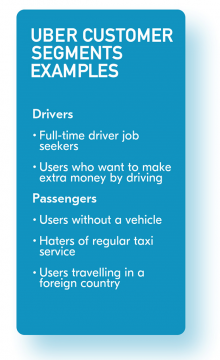
Value Propositions
Each Persona has a set of problems or needs that your product/service can solve. And that’s what you need to specify in the Value Propositions section. For this, we advise you to make use of the Jobs To Be Done framework.
Answer to: What problems and needs can you solve with your product?
Domain knowledge required:
- Personas
- Jobs To Be Done
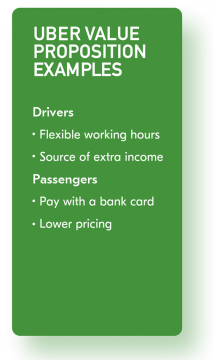
Channels
A channel means a communication unit that entrepreneurs use to reach customer segments. If you’re selling your products via a website – that’s one of your channels business model canvas. Other solutions that draw customers’ attention to your products are also channels. These may include search engines and tools, social media, and even word of mouth marketing.
Answer to: Which are the optimum channels to reach your customer segments?
Domain knowledge required:
- Personas
- Market behavior
- Budget
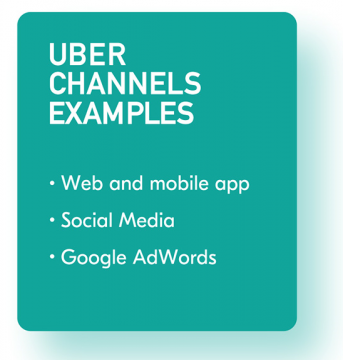
Customer Relationships
This section defines how you interact with customers. It goes beyond the sale-and-purchase interplay via the Channels. Business model canvas Customer Relationships involve post-sales liaison and feedback. If you use a call center or a chatbot to interact with users, mention them here.
Answer to: Which type of interaction suits best to each customer segment and how much do they cost?
Domain knowledge required:
- Personas
- Budget
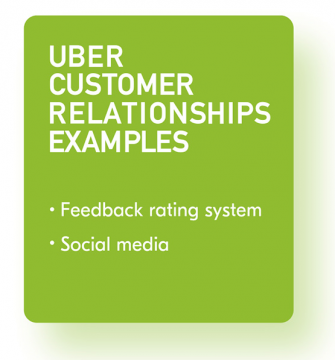
Revenue Streams
Revenue Streams list the ways you use to get money for your product. They mostly derive from mapping Customer Segments to Value Propositions. For example, Uber passengers pay for their ride with a bank card. Uber gets revenue in the form of a ride commission. Other ways that generate money within your product are also revenue streams. These may include different billable add-ons, subscriptions, premium accounts, etc.
Answer to: What exactly do your customers pay for?
Domain knowledge required:
- Personas
- Jobs to be done
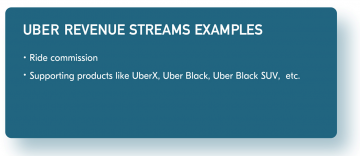
Key Activities
Now, the tough part begins. Key Activities cover all the things you need to accomplish to make your business work. For digital products, this involves ongoing product evolution and marketing. These activities, in turn, include recruiting, advertising, etc. If you deliver specific services, this may cover things that refine your propositions. When doing Key Activities business model canvas, take into account other sections you’ve already filled in.
Answer to: What do you need to implement for your business to deliver value to your customers?
Domain knowledge required:
- Jobs to be done
- Budget
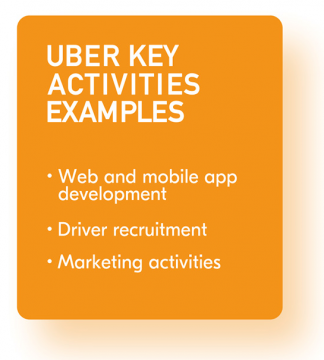
Key Resources
Key Resources are the assets you need to run your business at full force. In other words, this is what you can’t do without. Uber rests on a sophisticated technological platform. Also, it requires drivers to complement its value proposition. Services-oriented businesses mostly rely on their staff and expertise.
Answer to: What resources can’t your business propositions do without?
Domain knowledge required:
- Jobs to be done
- Budget
Key Activities:
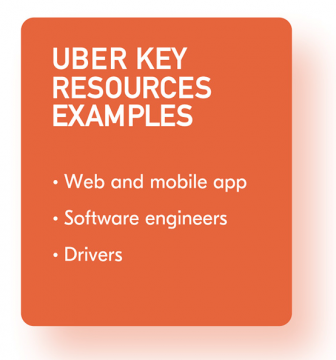
Key Partners
Now, let’s take a look towards external things that can contribute to your business. Key Partners is the section for this. Here, you need to define all the external stakeholders. We advise you to map them to Key Activities and Key Resources if any. For Uber example, investors can contribute to developing tech platform. Recruiting partners can help with hiring drivers. And so on.
Answer to: Which external stakeholders can contribute to your business?
Domain knowledge required:
- Jobs to be done
- Budget
Key Activities & Resources
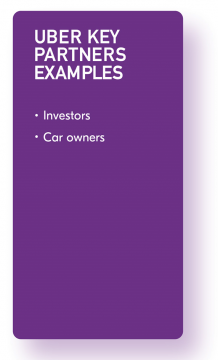
Cost Structure
It’s time to strike a balance:) Actually, Cost Structure should tell you what you spend money for. Also, you need to specify prospective costs if your business is growing. This section covers costs for hardware purchases, software development, rental services, and so on.
Answer to: What are you paying for and which costs are most important in your business model?
Domain knowledge required:
- Jobs to be done
- Budget
Key Activities & Resources
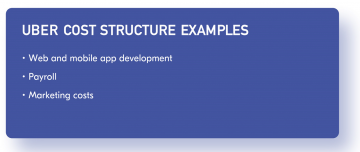
That’s it. Once you have it done, the next step ahead is business model canvas analysis. You have a broad picture of things in your business and can discover bottlenecks. Also, make sure to share it with stakeholders to refine the content. The canvas is a flexible document, so you should not feel obligated to stick to the first version.
Why entrepreneurs hate business model canvas
A coin always has two opposite sides, unless you’re using Harvey Dent’s lucky coin:) It means that the business model canvas is not a one-size-fits-all tool. And here are some reasons why you may want to abandon it.
- Learning needed
You’ve read this business model canvas review and learned the basics on how to fill it in. Some enthusiasts prefer to skip this step and get at working with the canvas right away. If you use it in the wrong context, it may be misleading for your analysis. - Iterative planning
The canvas requires an iterative approach to working with it. It means you have to update it regularly according to the business flow. Using the canvas for linear planning won’t let you experience business model canvas benefits to the full. - Not full picture
The canvas lacks important business facets like existing alternatives, regulatory environment, and others. Planning without them can be a dead-end road. In this regard, the lean canvas offers you broader horizons. So, it’s essential to understand the purpose of the business model canvas. It can be a great augmentation to other business analytical tools you use. - Too simple
Simplicity is not always a benefit. As a rather easy-to-use tool, the business model canvas cannot dive deep in analytics. Generally, it is an actionable communicative tool to get a general overview of the business flow. But, you should not rely on it as a full-fledged analytical tool.
A solid alternative to the Business Model Canvas
It’s clear that the Business Model Canvas has its limitations, even when it’s combined with the Value Proposition Canvas tool. Since neither allows you to delve deep into the context of your product idea, it’s likely that you will need to make use of another tool in order to achieve this.
We recommend using BRIDGeS, an all-in-one tool for flexible idea generation, validation, and selection. When compared directly to the Business Model Canvas, BRIDGeS bears several key advantages, including the fact that it’s versatile, easy to use, and allows for deep context understanding. The framework also gives you the opportunity to analyze a Subject from all angles in order to discover new insights or approaches. By the end of the process, you won’t just have a general overview of the problem you are trying to solve — you’ll have a firm idea of how to move forward with your business/product idea.
To get a better understanding of how BRIDGeS compares to the Business Model Canvas, check out the Uber Case Study.
Not sure if you should try the Business Model Canvas?
We would not pressure you to go with Osterwalder’s canvas. It is a specific tool and not every business can benefit from it. If, however, you’d like to give it a shot, we do advise you to start with the value proposition canvas***. It’s derived from the business model canvas components – Value Propositions and Customer Segments. At the same time, it lets you understand the value of your product/service from the customer’s standpoint.
If you are a startup founder, BRIDGeS or the Lean Canvas is what you need from the outset. Check out how Amazon, Google, and other big names could have taken advantage of the lean canvas tool earlier. As an all-in-one tool, BRIDGeS can also be beneficial for nailing down your product idea during the early stages of your startup journey. Apart from that, it probably won’t be until your business is up and running that you’ll understand if other discovery tools are a better fit or whether the Business Model Canvas is the way to go.
* Lean Canvas was designed by Ash Maurya, based on the Business Model Canvas designed by Alex Osterwalder, Strategyzer.com, licensed under CC BY SA 3.0.
** Business Model Canvas is designed by Alex Osterwalder, Strategyzer.com, licensed under CC BY SA 3.0.
*** Value Proposition Canvas is designed by Alex Osterwalder, Strategyzer.com.
